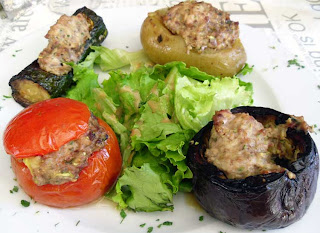But sometimes the high-end restaurant is too rich at any time, or doesn't serve lunch at an affordable price or even at all. There's a workaround for that: the little sibling from the same celebrity chef. In Chicago, these restaurant interrelationships are so numerous that they're almost incestuous. Instead of visiting Girl and the Goat for dinner, we dined at Little Goat just across the street (which is possible nearly any time of day). We eschewed BellyQ for Urban Belly, which shares the chef, the building, and a few of its big sib's menu items. And we got a three-fer of chefs Scott Harris of Mia Francesca, Tony Mantuano of Spiaggia, Jimmy Bannos and Jimmy Bannos Jr. of Heaven on Seven by choosing the small-plates restaurant The Purple Pig.
 |
| Marinated Chinese Eggplant with Thai Basil & Crispy Shallot at Urban Belly |
The technique for uncovering these places is easy. First, find the well-regarded chefs in a place you're visiting. This is probably the easiest part. If you're already stumped, visit food sites such as Food Network and Bravo's Top Chef and use the city's name as a starting point.
Maybe there's a profile article somewhere that lists all of that chef's restaurants to study further. If not, couple the chef's name (or just the term "chef" with the name of the city) with "affordable" or "approachable" and search away. Even if you don't find the most famous candidates for affordable meals that represent the local cuisine, you'll definitely find something worth exploring.








